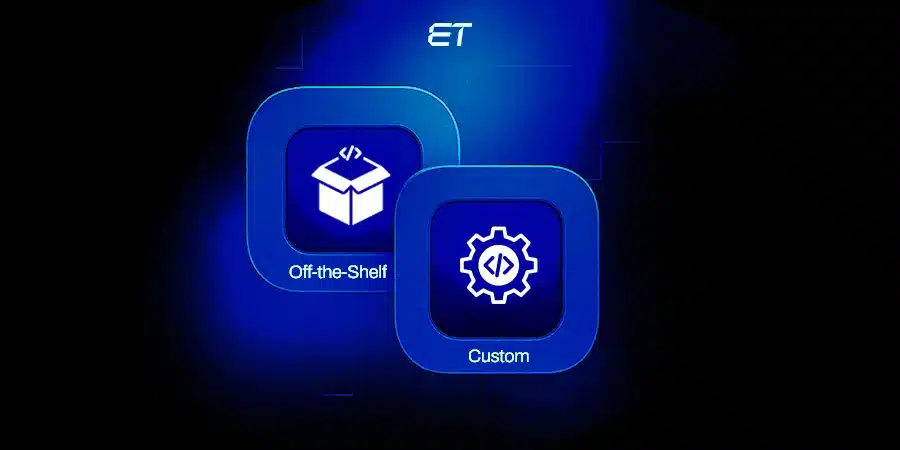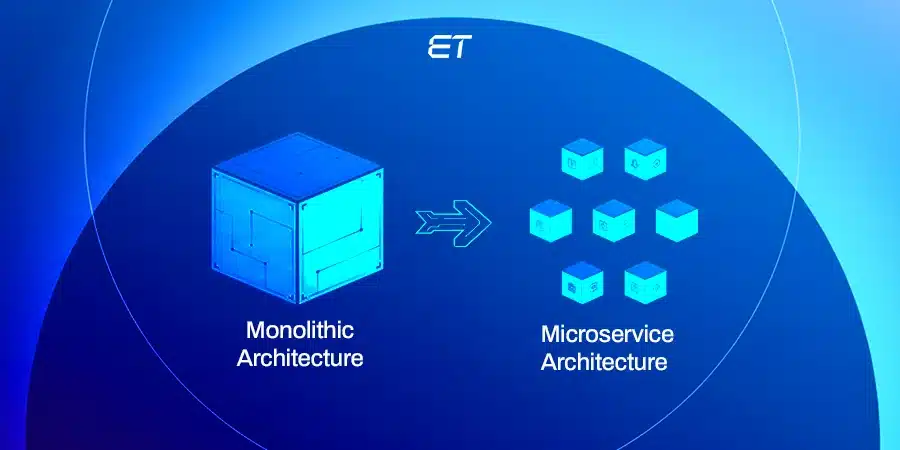
Monolithic vs. Microservices- A Deep Dive for Modern Architects
Every outage has an architecture behind it. The way a system is designed, how its components interact, scale, and recover, determines whether it bends under pressure or collapses entirely. More than coding, architecture is about resilience, agility, and long-term business viability.
According to a report by CIO Dive, IT downtime costs enterprises an average of $76 million per year. For today’s CTOs and enterprise architects, few choices carry more weight than the decision between Monolithic and Microservices architectures.
It is not a matter of preference but a defining factor in how an enterprise system will scale, adapt, and withstand failure.
Monoliths are a single, unified codebase—making it easy to build fast, deploy quickly, and manage in the early stages. But as systems scale, they often become rigid, tightly coupled, and vulnerable to widespread failure.
Microservices, on the other hand, break down applications into independent services, bringing modularity, fault isolation, and flexibility. The trade-off? More complexity in orchestration, data consistency, and day-to-day operations.
So the question is not which model is “better,” but which one aligns with your scalability needs, risk tolerance, and business strategy.
Understanding the Monolithic Approach
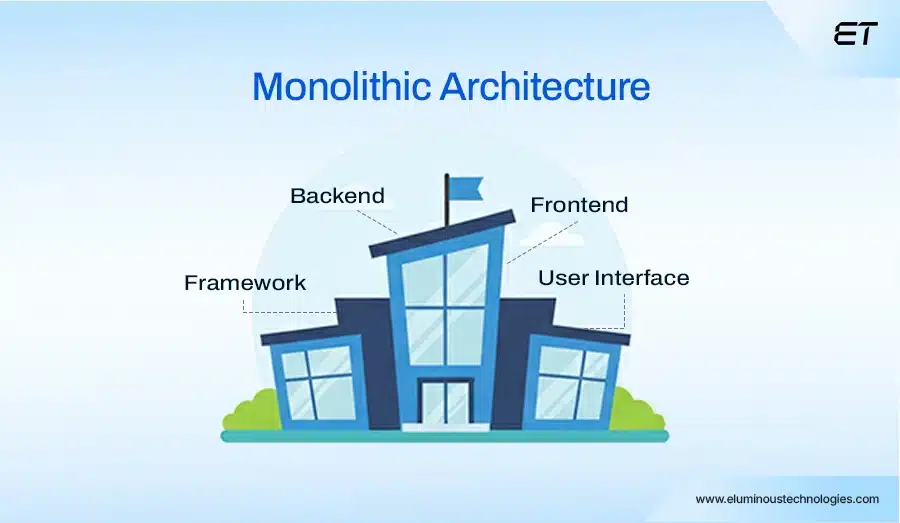
A monolithic application is built as a single, cohesive unit, where every component, from the user interface to business logic and database, exists within a single, tightly coupled structure.
It can be compared to a single-structure building where all rooms rely on the same foundation. While this design simplifies construction and maintenance, a fault in one area can disrupt the entire structure—just as a failure in one component of a monolithic application can impact the whole system.
Anatomy of a Monolith
Most monolithic systems follow a classic three-tier structure:
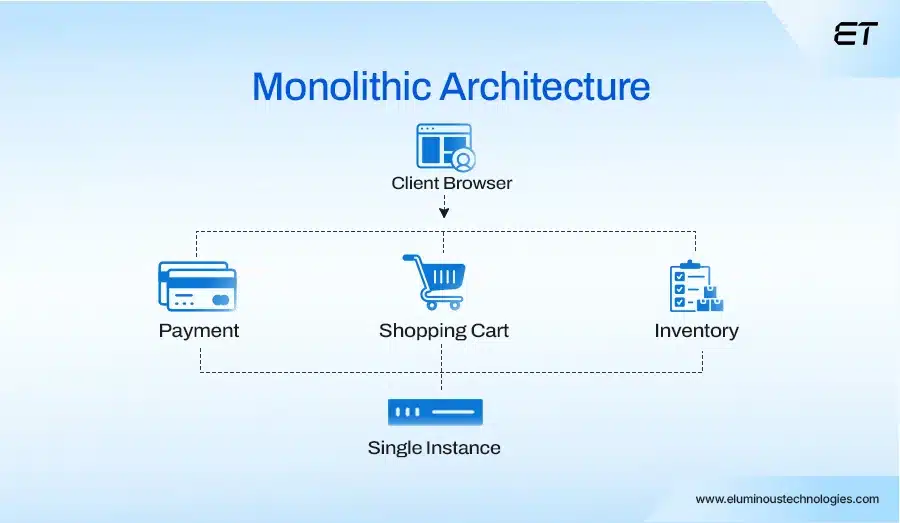
- Client-side UI – the front-end interface users interact with.
- Server-side Application – the business logic layer that processes requests.
- Database – a single data store supporting all functionality.
Because everything is interconnected, monoliths are simpler to design and deploy. Developers can build and launch features quickly without worrying about complex integrations across multiple services.
For example, Basecamp (formerly 37signals) has famously continued with a monolithic architecture, citing simplicity, speed of development, and reduced overhead as key reasons for avoiding microservices. Today, they are serving millions of users across 180+ countries, and the monolith still delivers the efficiency their business demands.
Monolithic Architecture: Advantages vs. Disadvantages
Understanding both the advantages and disadvantages of a monolithic approach is crucial for architects and decision-makers, as it reveals where this model excels and where it can hinder an enterprise.
| Advantages | Disadvantages |
| Simplicity & low overhead – easier to develop, test, and deploy initially. | Scalability limitations – the entire application must be replicated, which is inefficient. |
| Performance – faster inter-module communication (internal calls vs. network). | Reliability – a bug in one module can bring down the whole system. |
| Simplified management – fewer moving parts, easier logging and monitoring. | Slower velocity – harder to maintain and slower feature deployment as the codebase grows. |
Did You Know? 94% of professionals say microservices are vital for building scalable, resilient apps. Discover the best frameworks for your next project.
Understanding the Microservices Approach

A microservices architecture is a suite of small, autonomous, and independently deployable services. Each is responsible for a different business function.
Unlike monoliths, which bundle everything into a single unit, microservices break an application into specialized parts that can be developed, deployed, and scaled independently.
Think of it as a campus where each building has its own purpose and yet together they form one institution. If one building closes for maintenance, the rest of the campus remains operational.
Similarly, in microservices, if one service fails, others can often continue unaffected.
Core Principles of Microservices
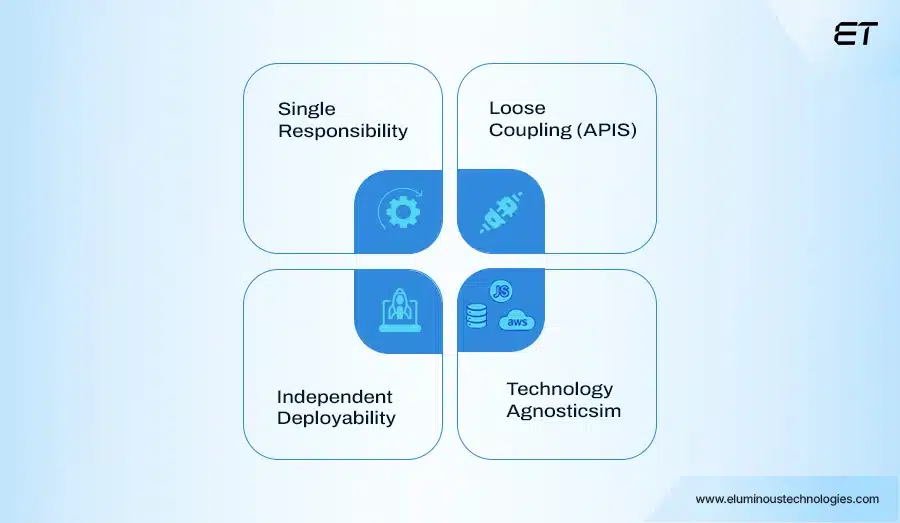
- Single Responsibility: Each service is designed around a specific business capability, such as payment processing or user authentication.
- Loose Coupling via APIs: Services communicate through lightweight protocols, such as REST, gRPC, or messaging queues, thereby minimizing dependencies.
- Technology Agnosticism: Each service can use its own programming language, database, and deployment framework—whatever best suits its purpose.
Amazon is a leading success story of microservices. By breaking its platform into services like catalog, payments, recommendations, and logistics, it scaled to handle hundreds of millions of transactions daily.
In the early 2000s, Amazon introduced the “two-pizza team” rule, which means each team should be small enough to be fed with two pizzas. In practice, this helps small, autonomous groups to own services end-to-end through independent APIs.
Microservices Architecture: Benefits vs. Challenges
While microservices come with agility and flexibility, they also introduce new layers of complexity. Below, we highlight the key benefits and challenges every enterprise should weigh before adopting this model.
| Benefits | Challenges |
| Independent scalability – scale only what’s needed, saving resources. | Increased complexity – managing distributed systems is harder (DevOps, monitoring). |
| Greater resilience – one service failure doesn’t crash the whole system. | Higher operational overhead requires orchestration tools (e.g., Kubernetes, service mesh). |
| Faster deployment – enables CI/CD with independent service releases. | Debugging difficulties – tracing requests across services is a challenging task. |
The serverless market is set to grow at a CAGR of 37.1% by 2025, while microservices power giants like Netflix, Uber, and Amazon. Curious which fits your next project?
Monolithic vs. Microservices: Real-World Case Studies and Practical Use Cases
For enterprises, the choice between monolithic and microservices architectures is one of the most consequential system design decisions.
In fact, as Martin Fowler points out, “almost all the successful microservice stories have started with a monolith that got too big and was broken up.” This perspective highlights that monoliths often provide the right foundation in the early stages, delivering speed and simplicity.
Over time, however, systems evolve, and it is then that the trade-offs emerge. As Sam Newman observes, “making decisions in system design is all about trade-offs, and microservice architectures give us lots of trade-offs to make.”
With this balance in mind, it is important to understand real-world use cases where each approach proves most effective.
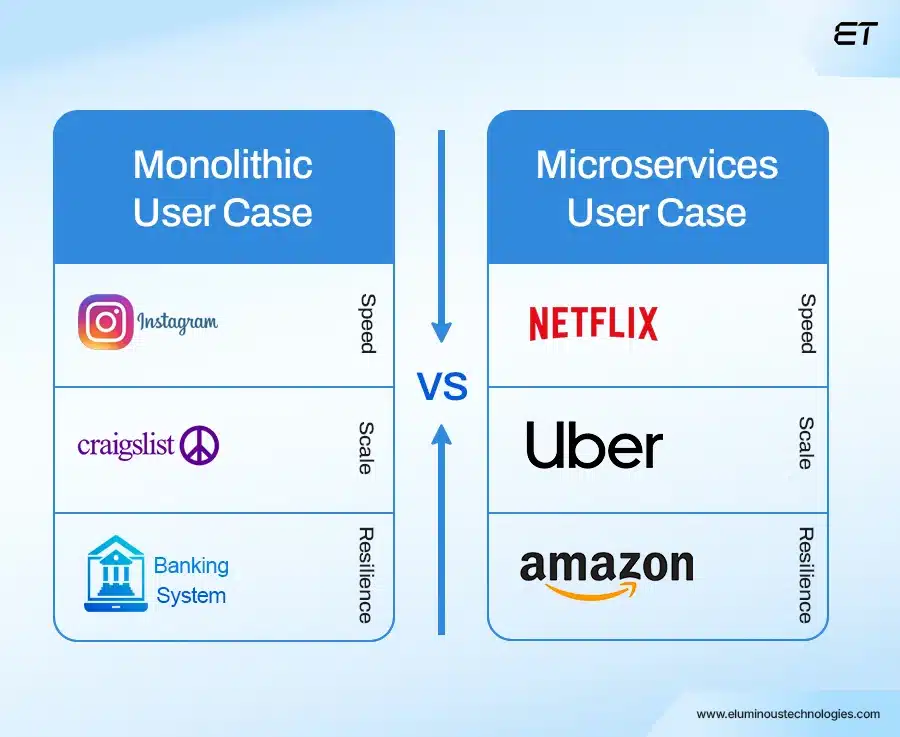
When to Choose a Monolith
- Startups and MVPs: When speed to market is essential, monoliths provide quick iteration with minimal overhead. Instagram, for example, scaled to handle 30 million users with just 13 engineers on a monolithic Django app before selectively decoupling services.
- Small Teams with Limited Expertise: Distributed systems require a deep level of DevOps maturity. A monolithic approach reduces overhead, as seen with Craigslist, which continues to run effectively on a largely monolithic Perl codebase.
- Low Scaling Requirements: For predictable workloads, monoliths remain efficient. Many banking compliance systems remain monolithic because transaction volumes are stable, and the risk and legacy cost of migrating to microservices outweigh the benefits.
When to Adopt Microservices
- Large, Complex Applications: Enterprises with interdependent modules benefit from modular services. Netflix shifted its legacy data after a 2008 database corruption outage left the platform down for three days. Today, its microservices support 270+ million global users streaming billions of hours each month.
- High and Variable Traffic: Businesses facing extreme traffic spikes need elastic scaling. For example, Ecommerce sites can scale their monolithic core with microservices principles to process heavy checkout requests during Black Friday without downtime.
- Organizations with Multiple, Autonomous Teams: Microservices Align with Decentralized Teams. The prime example here is Uber, which adopted microservices to scale globally, expanding to over 2,200 services, but also faced challenges with “service sprawl” and complex debugging—emphasizing the importance of governance and tooling.
Ready to Build Smarter Apps? Micro apps are lightweight and designed to solve one problem really well. Transform how your business delivers digital solutions.
Migration Strategy From Monolith to Microservices
Migrating from a monolith to microservices is rarely executed as a single step; it is usually a gradual process.
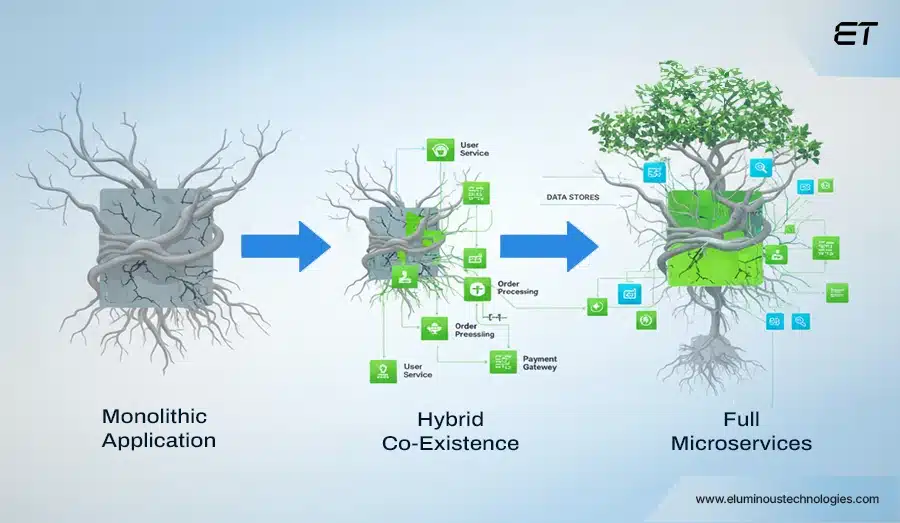
Most organizations begin with a monolithic system and transition incrementally as scalability, modularity, and operational needs increase. A widely adopted approach is the Strangler Fig Pattern, where new microservices are introduced to replace specific functionality while the monolith continues to run in parallel.
Over time, as more responsibilities are offloaded, the monolith is inactive. Another strategy is the Modular Monolith, where the application is structured with well-defined boundaries between domains but still deployed as a single unit.
This design allows for the separation of concerns and prepares the system for eventual decomposition into independent services without the immediate overhead of a distributed infrastructure.
Making the Right Choice for Your Project
Choosing between a monolithic and microservices architecture is not about finding the “perfect” model, but rather about aligning your system design with the realities of your business, your teams, and your long-term goals.
An effective way to approach this decision is to step back and ask a few critical questions.
1. Application Scale and Complexity
If your app is small or you are shipping an MVP, a monolith keeps things simple and fast. But if you’re building for the scale of an Amazon-style marketplace or a Netflix-level platform, microservices give you the modularity to grow without breaking.
2. Team Structure and Expertise
A small, centralized team can move faster with a monolith—less coordination, fewer moving parts. Microservices only pay off when you have multiple autonomous teams and the DevOps maturity to manage them.
3. Budget and Resources
Monoliths are lean: you can get started without investing heavily in infrastructure or tooling. Microservices, on the other hand, come with costs such as Kubernetes clusters, monitoring stacks, and service meshes that only make sense if your business can sustain them.
4. Business Goals and Time-to-Market
Need to launch quickly? A monolith gets you there fastest. Planning for long-term growth and constant iteration? Microservices will give you the agility to keep evolving without hitting architectural walls.
Outcome? Monoliths excel in simplicity and speed, whereas microservices help in scalability and sustainability. The best architecture is the one that aligns with your team, resources, and ambitions.
Wrapping Up
Choosing between monolithic and microservices architectures is ultimately depends on enterprises’ trade-offs. Trends such as serverless computing, containers, and service meshes are reshaping how enterprises approach architecture, offering new ways to strike a balance between agility and control.
In practice, the future may not be purely monolithic or purely microservices, but a thoughtful mix that adapts to changing demands.
If your organization is evaluating the shift from monolithic to microservices architectures, the key is to align technology with business priorities, team capabilities, and long-term goals. To discuss the right strategy for your enterprise, book a consultation with our team for tailored architectural consulting and guidance.
Build the Right Architecture for Tomorrow. Whether you lean towards monolithic or microservices, our experts help you align technology with growth.

